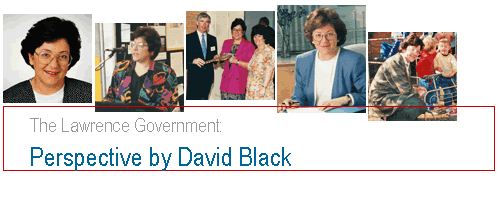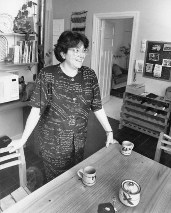
Background
In February 1983 the Labor party, led by former journalist Brian Burke, was elected with a comfortable majority in Western Australia’s Legislative Assembly. Between 1924 and 1947 the ALP had occupied the Treasury benches in WA for all but three years: by contrast after 1947 the party was in power only between 1953 and 1959 and (with a majority of one seat) between 1971 and 1974. Burke, himself the son of a former federal Labor MP, was sworn in on his 36th birthday as the third youngest Premier in the State’s history.
He came to power with an agenda focussed on developing financial links between government and business as a means of enhancing the development of the state without the necessity of recourse to higher government levels of taxation. Initially, and despite ongoing Opposition resistance in the Legislative Council, the government went from strength to strength politically.

Curtin University Library. Carmen Lawrence Collection. Records of Carmen Lawrence. Carmen Lawrence, 1990. CUL00005/2/2
When, after only five years in power, Burke (and his deputy Malcolm Bryce) resigned from the government and the Parliament in February 1988, their political reputations still very high. However the storm clouds were already gathering with the October 1987 stock market crash and a series of controversial government financial involvements. These included bailing out the failed Teachers’ Credit Society, providing a government guarantee to prevent the collapse of Rothwells Merchant Bank owned by business man Laurie Connell, and contributing through the Government Employees Superannuation Board (GESB, formerly the State Superannuation Board) to the cash-strapped Bell Group owned by Roberts Holmes A’Court. Subsequently a proposed petrochemical plant at Kwinana, structured as a private consortium but with substantial government involvement, did not proceed beyond the design stage. The plant was eventually sold with the government agency WA Government Holdings providing nearly half the purchase price.
In this context the term WA Inc. was coined by critics of the government to describe the array of government dealings with private business ventures, the establishment of the government’s own WA Development Corporation and the involvement of business entrepreneurs in ALP party fund raising through the John Curtin Foundation. It is against this background that the tenure and achievements of the Lawrence Government have to be understood.
The first woman premier
Carmen Lawrence became Australia’s first woman Premier on 12 February 1990. This was just a year and a week after the Labor government in Western Australia led by Peter Dowding had been returned with a small but workable majority at the 1989 election. Dowding had been endorsed by the ALP parliamentary party as its leader on 25 February 1988 following the resignation of Burke and Bryce and at a time when the spectre of WA Inc. was beginning to loom. Dowding’s electoral appeal was widely credited with Labor’s against the odds win in the February 1989 election even as the party secured less than half the two party preferred vote.
However, the government’s problems multiplied in the ensuing twelve months as the sale of the proposed petrochemical plant (PICL) proceeded and the Government Employees Superannuation Board lost a significant sum with the collapse of the Bell Group. These and other developments related to government-business relationships produced a political backlash against the government. On 7 February 1990, a majority of the State Parliamentary Labor Party called for the Premier (who was overseas at time) to step down. At the ensuing cabinet meeting on 12 February, Dowding and his deputy David Parker resigned and they were replaced by Dr Lawrence with Kalgoorlie MLA Ian Taylor as her deputy.
Rapid rise to leadership
The new premier had entered the Legislative Assembly for the first time four years earlier, in 1986, when she won the formerly Liberal held seat of Subiaco with 50.2% of the primary vote in a three cornered contest. In the process she defeated former federal Liberal MHR Ross McLean. After only two years in Parliament she was appointed Minister for Education in Peter Dowding’s first ministry. In the 1989 election, Lawrence stood for and won the newly established seat of Glendalough by 1700 votes and with 55% of the vote after preferences. Following this, she was also appointed as Minister for Aboriginal Affairs.
Born and raised in the Western Australian wheat belt, Carmen Lawrence was educated in Catholic schools and in her final year of secondary study in 1964, she was awarded a general and special subject (Economics) exhibition. She studied at the University of Western Australia where she graduated in Psychology, won the J A Wood memorial prize, and went on to complete her Ph.D. In 1978 she joined the ALP and from the outset she was regarded as a rising star in the party.
The first Lawrence ministry
The Lawrence cabinet was announced on 18 February 1990 and ministers were sworn in on the following day. Responsibility for government finance was placed in Lawrence’s hands as Premier and Treasurer. In addition, Lawrence was Minister for Public Sector Management, the Family, Aboriginal Affairs (for which she had been minister since 1989), Multicultural and Ethnic Affairs and Women’s Interests.
She did relinquish the Education portfolio which she had held since February 1988. Deputy Premier Ian Taylor was Minister for Finance and Economic Development (as well as for the Goldfields). Former Deputy Premier David Parker was retained in the ministry as Minister for Resources, Trade and the Arts but both Peter Dowding and former minister Julian Grill retired to the backbenches.

Curtin University Library. Carmen Lawrence Collection. Records of Carmen Lawrence. Newly elected Premier Carmen Lawrence at home, 1990. CUL00005/3/76
Initial electoral climate
In April the composition of the government altered further with the resignation of David Parker from the ministry and Parliament. Soon afterwards Peter Dowding also announced his decision to leave politics, leading to by-elections being held in Fremantle and Maylands on 25 May 1990. However, in what was interpreted as electoral support for the change in Labor leadership, the expected adverse swings in the two ‘safe’ seats were limited to 7.6% and 4.7% respectively. Indeed the latter figure represented the lowest anti government swing in any of the nine by elections since Labor had returned to power in 1983.
The new member for Fremantle, Jim McGinty, was subsequently to serve as deputy premier in the Gallop and Carpenter Labor governments and as Leader of the Opposition in the mid 1990s. The new Maylands MLA, Dr Judith Edwards, also held ministerial posts for many years in both those governments.
Earlier the change in leadership seemed also to have enabled the ALP to minimise its losses in the March 1990 federal election. Although recording only 47% of the two party preferred vote in WA, the lowest figure in any of the six states, the ALP won 8 of the 14 seats compared with 9 of the 13 seats in 1987. This, along with the May State by elections, indicates that the change of leader had sheltered Labor from the immediate fall out from the WA Inc issues including the failure of the PICL petrochemical project and the significant financial losses for the GESB and State Government Insurance Commission.
However, the Government remained under strong pressure from the non-Labor opposition and other outside sources (including the People for Fair and Open Government, an activist organisation founded in 1989 and headed by the Premier’s brother, Bevan Lawrence) to establish a Royal Commission of inquiry. There was also pressure from some quarters for the Coalition-dominated Legislative Council to block supply and force an early election. As it eventuated, although the threat to supply was supported by Opposition leader Barry MacKinnon, a meeting of the Coalition’s upper house members refused to adopt this course of action. In addition, MacKinnon himself had to survive a leadership challenge from deputy leader Richard Court who then stood down for the time being from his position as deputy leader.
Power station options
One major issue confronting the new government was the need to decide between a number of options for the location and nature of an urgently required new power station: this included choosing between a coal-fired or gas-fired station, between a government -owned or private power station, and between a site which impacted on a national park or an alternative location.
A power options review committee, the Harman Commission, was appointed at the end of 1989. It released its finding in June with the majority view favouring a gas-fired station, with a coal-fired station near Collie as the second best alternative. A minority report preferred a private power station in the Hill River area 220 km from Perth.
No decision was taken in the immediate aftermath of the report but in May 1991 the government decided to opt for a coal-fired power station at Collie, the first privately owned and operated (by Transfield-Mitsubishi) station to supply a public grid in the State. The decision was probably influenced by vigorous trade union campaigns in favour of a coal-fired station. Energy Minister Geoff Gallop was able to extract concessions in terms of productivity and price in return for not adopting the gas option.



